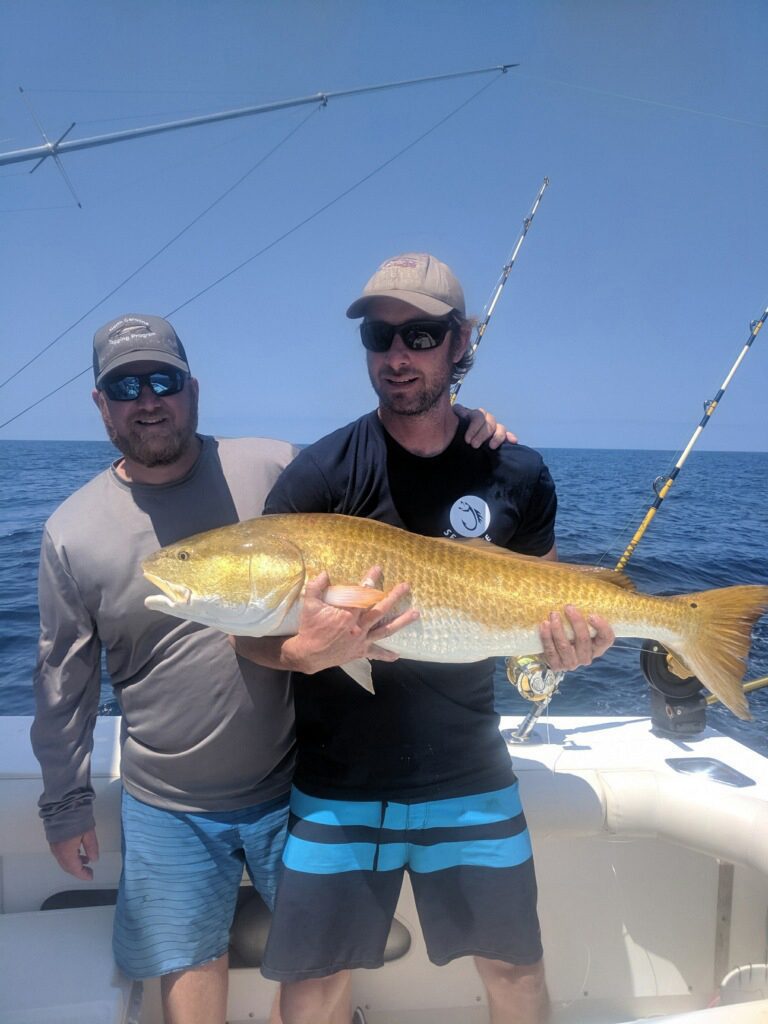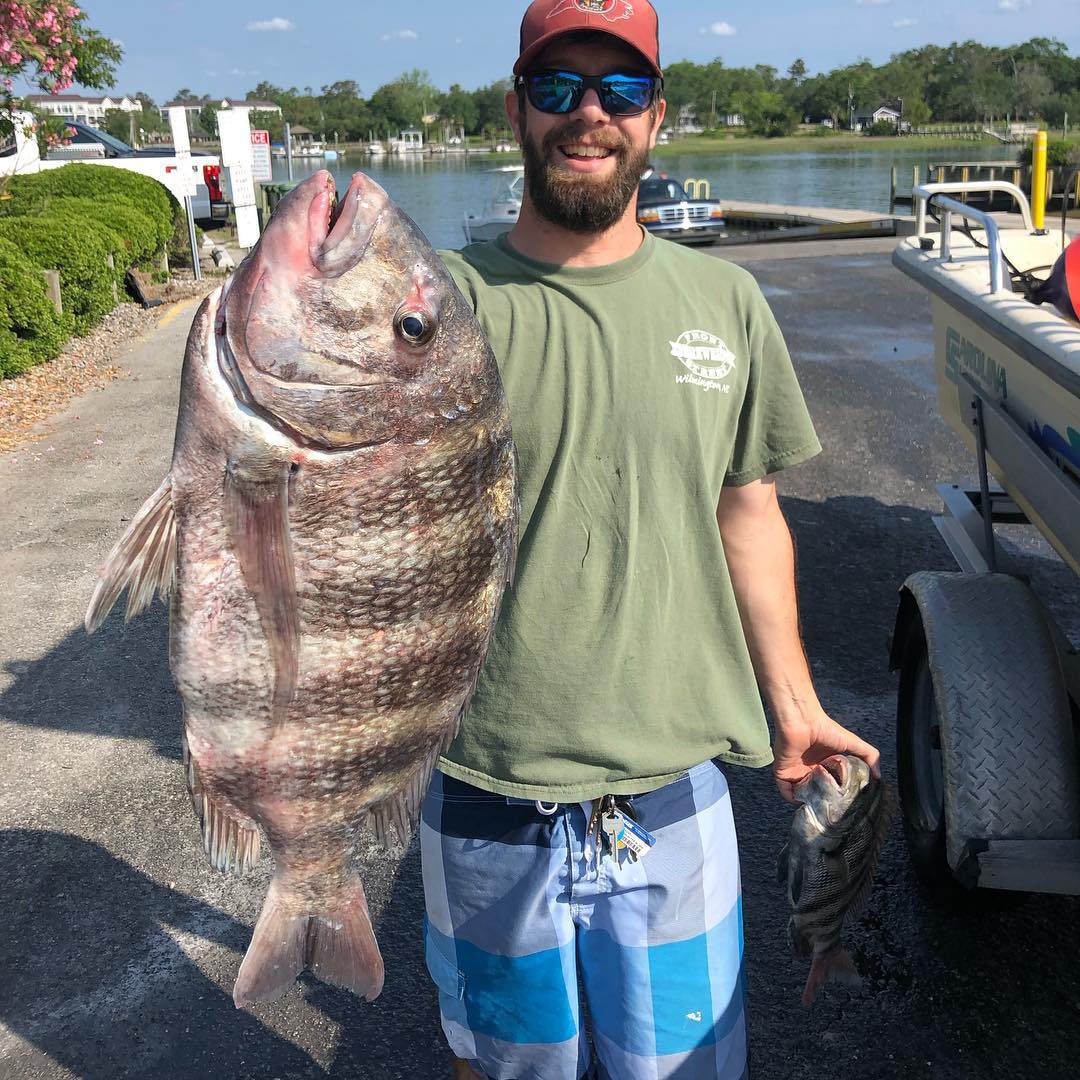Wrightsville Beach – June 20, 2019
Matt, of Tex’s Tackle, reports that fishing for redfish has been decent for inshore anglers, with most of the fish being caught on topwater plugs early and then soft plastics throughout the day.
Keeper flounder are being caught inshore, and live bait and Gulps are accounting for most of the fish. They can be found near the inlets and in the creeks on the mainland side, but it usually takes some structure and current to find better numbers of flounder.
The sheepshead and black drum fishing has been good around bridges, docks, and oyster bars. Fiddler crabs, sand fleas, and shrimp are the best baits.
In the surf, bluefish, pompano, spanish mackerel, croaker, black drum, red drum, and flounder have all been reported. Surf fishing during the summer is often better during the cooler times of day or at night.
The spanish mackerel fishing has been great at the nearshore wrecks and ledges. There have been some citation-sized fish mixed in, especially for boats fishing with live bait. Anglers have also been catching blues, kings, and a few false albacore in the same areas.
Citation-sized flounder, gray trout, and some big drum have been biting on the nearshore bottoms. Use a bucktail tipped with Gulp or a live mullet or menhaden.
King mackerel are being caught in great numbers at structure and ledges throughout the area. The kings are being caught from the beach right on out to the 30 mile range. Ballyhoo and cigar minnows, Drone spoons, bigger Clarkspoons, and live bait will all produce fish.
There’s been some decent fishing for mahi inshore of 30 miles. They are usually chasing flying fish, so try to match your trolling spread to the size of the bait you see in that area.
The gag grouper bite, along with some beeliners, pinkies, and grunts, has been steady starting in about 90’. The reds and scamps can be found further offshore, along with good numbers of triggerfish.
Gulf Stream anglers have reported some strong mahi fishing, along with decent numbers of sailfish and blue marlin. Finding the temperature breaks and weed lines has been the key to success, and most boats have been fishing around 100 fathoms.

Pat Freeman and Joe Sebes with a 42″ red drum that was caught in 100′ of water near the Nashville Wreck using a #6 planer and Drone spoon. They were fishing about 35 miles out aboard the “Jimmy Crab” with Capt. Jimmy Hobbs.
Arlen, of Intracoastal Angler, reports that red drum fishing has been red hot throughout the area, as the drum have begun to fall into their summertime patterns. Smaller slot-sized fish have been coming from several mainland creeks, such as Hewletts and Bradley creeks, mostly along the docks on live minnows and scented soft plastics. Upper-slot to over-slot fish are coming from the flats behind Masonboro Island and Rich’s Inlet. Rapala Skitterwalks and gold spoons have been the most productive.
Flounder fishing has remained steady. The best numbers are coming from Masonboro and Carolina Beach inlets, and live bait and squid strips fished on the bottom have produced fish up to 4 lbs.
Sheepshead fishing has been good along the waterway docks and bridges, with live fiddler crabs as the bait of choice.
Spanish fishing has seen the best action a few miles off the beach on Clarkspoons and casting jigs. Flounder fishing the nearshore reefs has remained hot, where Spro bucktail/Gulp combos have produced several citation-sized fish.
King mackerel fishing has been good in the 7-10 mile range. There’s been a few stray dolphin caught in the same areas. Dolphin fishing has been better in the 20 mile range, though, with trolled ballyhoo producing fish up to 15 lbs.
Gag grouper fishing has been consistent. The best catches have been around 23 Mile Rock.
Gulf Stream anglers have reported several billfish encounters, mainly from blue marlin in 150 fathoms from the 250 line north. Gaffer dolphin fishing has remained strong as well, and there’s still a few wahoo mixed in.
Jamie, of Seagate Charters, reports that redfish are biting well in area creeks near inlets. Live and cut menhaden have produced the most bites, though Fathom inshore plastics and Skitterwalks have been working as well.
Flounder action is hot in the creeks, where live bait has proved the most effective. The flatties have been biting in the ocean as well. Jerk shads on 3/4 oz. jig heads or live bait-tipped bucktails will work for the offshore flounder.
Spanish fishing has been good up and down the beach. Traditional spoon and planer setups, as well as Blue Water Candy casting jigs, have been catching plenty of fish.
Kings are in the 3-5 mile range, where cigar minnows or live menhaden will do the trick.

Joseph Bagwell with a 7.5 lb. sheepshead he caught using a fiddler crab on a Carolina rig. He was fishing a dock in Wrightsville Beach.
Trevor, of ProFishNC Charters, reports that flounder fishing is on fire right now, with mud minnows or artificials on a jig head producing the most bites. Most of the fish have been hanging around inlet mouths and estuary docks.
Red drum fishing has slowed in the backwaters due to recent rains, so most of the fish can now be found near inlet mouths.
Nearshore fishing has improved, with king and spanish mackerel holding right off the beach. Ballyhoo on Hank Brown rigs have been getting lots of bites. Mahi have moved out to the 23 mile area and can be caught on just about anything.
Nearshore flounder are biting bucktails or live bait around artificial reef structures.
Rick, of Living Waters Guide Service, reports that the mahi bite continues, along with a few wahoo and blackfins.
Bill fishing has been amazing, with blues, whites, and sails all biting.
Bottom fishing is excellent from 80-130’ for groupers, grunts, pinkies, beeliners, and triggers.
Nearshore spanish mackerel are biting, along with kings, in anywhere from 30-70’ of water. Look for bait—that’s where the fish will be.
Gabe, of Johnnie Mercers Pier, reports an increased flounder bite. Most are undersized, but a few keepers have been mixed in. Black drum have been feeding as well. Fresh shrimp is the best option for both the flounder and drum.
Large bluefish are being caught on Gotcha plugs.





